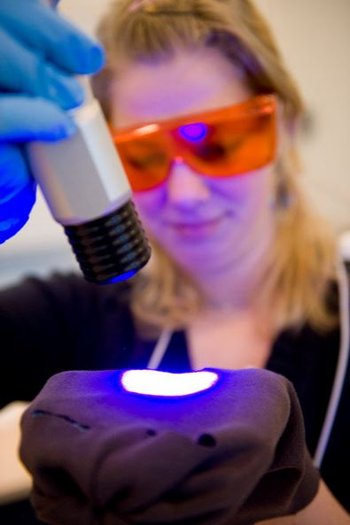microfluidic devices for presumptive forensic tests
Brigitte Bruijns is a PhD student in the research group Mesoscale chemical systems. Her supervisor is prof.dr. J.G.E. Gardeniers from the Faculty of Science and Technology.
 Sampling and securing traces at a crime scene is a crucial step in the investigation process. Information obtained at this stage immediately gives direction to the investigation. The aim of this project was to develop a microdevice that enables the investigator at the crime scene to screen traces for their possibility of containing (human) biological material. This presumptive test gives an answer to the question whether or not there is (human) DNA present in the sample.
Sampling and securing traces at a crime scene is a crucial step in the investigation process. Information obtained at this stage immediately gives direction to the investigation. The aim of this project was to develop a microdevice that enables the investigator at the crime scene to screen traces for their possibility of containing (human) biological material. This presumptive test gives an answer to the question whether or not there is (human) DNA present in the sample.
The process of DNA analysis can be divided in five consecutive steps: trace sampling, sample work-up, amplification, detection and secure storage, which were all investigated in this research. Trace sampling is conventionally carried out by the use of a (cotton) swab, despite the fact that the performance is low in terms of sample release. A ceramic collection tool, an alternative for the standard swab, showed promising results. Thermal lysis, part of the sample work-up, is a fast and simple method for on-chip cell lysis of the trace sample. Amplification of the DNA is needed, since crime scene samples often contain low amounts of DNA. Isothermal techniques, such as multiple displacement amplification and helicase dependent amplification, are suitable for sensitive and fast on-chip amplification. For the detection DNA dyes can be used of which the increase in fluorescence along the amplification can be monitored in time. The biological sample in the chip is present in an enclosed environment, which limits the risk of (cross-)contamination and improves the chain of custody.
Various microfluidic devices were designed, developed and tested to achieve on-chip lysis, amplification and detection. The majority of these chips were made of cyclic olefin copolymer, since the material is biochemical compatible, resistant to many chemicals (acids, alkaline solution and common solvents) and optically transparent.





